

Take your pick - Facilitating, leading, managing, hosting, community-ship. It all started with Euan Semple’s insightful post on knowledge ecologies (not economies or markets ). It resonated with me so much that I celebrated Euan’s post by reviewing each point through the eyes of a Community of Practice facilitator. Prior to this I touched on one point called " follow the energy ", which is what the spirit of social business design or enterprise 2.0 is all about. A discussion on G+ led to points about control, managing, leadership, and facilitation; which Luis Suarez has kindly summarized. A few notable points in the discussion: One of the key concepts which links with any ecological approach is co-evolution. Knowledge Management or Experience Management? One of our clients has contracted us to provide them with guidance into "Experience Management".

The term "Experience Management is not a commonly defined term, so I was very interested to understand what they meant by the term (and they weren't talking about managing customer experience, which is a different field). Resolving the Trust Paradox. I love paradox, as anyone can tell from the name of the research center that I run with John Seely Brown in Silicon Valley – the Center for the Edge.
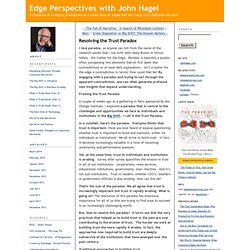
Paradox is basically a puzzle, often juxtaposing two elements that at first seem like contradictions or at least defy explanation. Isn’t a center for the edge a contradiction in terms? How could that be? By engaging with a paradox and trying to sort through the apparent contradiction, one can often generate profound new insights that expand understanding. The danger of maturity models in KM (and the alternative) I know that KM Maturity models are popular as a way of self-measuring progress, but personally I think they are inappropriate and can lead you into a wrong understanding of KM, and that there are much better alternatives.
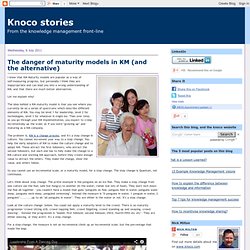
Let me explain why! The idea behind a KM maturity model is that you see where you currently lie on a series of spectrums which describe different elements of KM. Four archetypes in KM. In this recent post I talked about four roles that a KM team can play - the publishing house, the library, the tour promoter and the help desk; all related to the four components of this KM Boston Square (explicit push, explicit pull, tacit push, tacit pull).
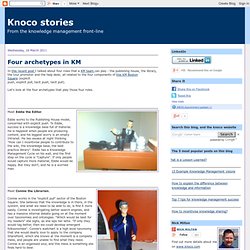
Let's look at the four archetypes that play those four roles. Meet Eddie the Editor. Knowledge Management: The Highway Analogy. Chris Collison (which I keep wanting to read as collision for reasons that will soon become apparent) is a KM consultant and author who will be speaking to 600 law librarians on the subject of mapping the KM landscape.
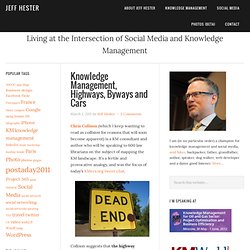
It’s a fertile and provocative analogy, and was the focus of today’s KMers.org tweet chat. Collison suggests that the highway represents the mainstream tools, techniques and functionality that are widely regarded as intrinsic to any decent KM environment. The four business focus areas for KM. We all know you shouldn't talk to business staff in KM-speak, but in the language of the business.
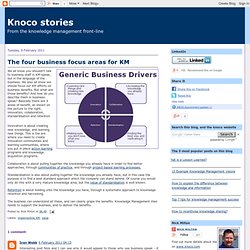
We also all know we should focus our KM efforts on business benefits. But what are those benefits? And how do you describe them in business-speak? Basically there are 4 areas of benefit, as shown on the picture to the right; innovation, collaboration, standardisation and retention. Le KM à l'heure des réseaux sociaux d'entreprise - Journal du Net Solutions. Knowledge Management 2.0. Les wikis, les blogs, le social bookmarking et les réseaux sociaux, ainsi que toute la panoplie des nouvelles pratiques et technologies 2.0 sont en train de révolutionner les processus du Knowledge Management.
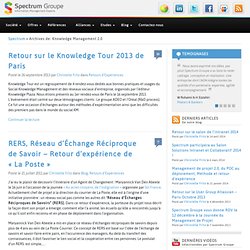
Oui, c’est bien de Knowledge Management dont on parle ! Ce vieux terme (relativement) est toujours là pour nous rappeler qu’au cœur de tous ces dispositifs c’est la connaissance qui est en jeu. C’est bien la connaissance qui est gérée dans ces systèmes, et de diverses manières : Transmettre les connaissances aux collaborateurs en relation client. Intégration « content management et entreprise 2.0. In praise of dialogue. • Why do children go to school to learn, rather than staying home and reading books?
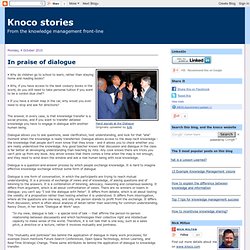
• Why, if you have access to the best cookery books in the world, do you still need to take personal tuition if you want to be a cordon blue chef? • If you have a street map in the car, why would you ever need to stop and ask for directions? The answer, in every case, is that knowledge transfer is a social process, and if you want to transfer detailed knowledge you have to engage in dialogue with another human being. Dialogue allows you to ask questions, seek clarification, test understanding, and look for that "aha" moment when the knowledge is really transferred. Dialogue allows access to the deep tacit knowledge - the knowledge that people don't even know that they know - and it allows you to check whether you are really understood the knowledge. Reasons knowledge management information systems fail - by Peter Hann. Peter Hann's image for: "Knowledge Management Information System" Caption: Location: Image by: A knowledge management information system is put in place with a particular objective, to capture knowledge where it is being created within the organisation.

Knowledge Management Incentives. The list below is an old document I found, based on a survey of a community of knowledge managers, which lists possible incentives for seeking knowledge, and for sharing knowledge.
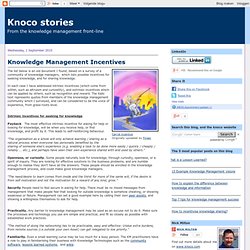
In each case I have addressed intrinsic incentives (which come from within, such as altruism and curioistity), and extrinsic incentives which can be applied by others, such as recognition and reward. The italic text represents quotes from members of the knowledge management community which I surveyed, and can be considered to be the voice of experience, from grass-roots level.
Intrinsic incentives for seeking for knowledge Payback The most effective intrinsic incentive for asking for help or looking for knowledge, will be when you receive help, or find knowledge, and profit by it. Egypt interview. Why should I share? Receiving, in order to give. Back in the days of the BP Knowledge Management program, in the late 1990s, we were travelling the world, spreading the news about Knowledge management and engaging different BP business units in conversation about the value KM could bring. One of our tours took us to South America, where we visited the Colombia Business Unit in Bogota. They had been doing some great work locally on the use of LiveLink to exchange and build knowledge, and we asked whether they would be prepared to share this work with the rest of the company. Collaboration types and tools. The failure to embed KM. Stephen Denning has published an interesting and thought provoking post, entitled "Why do great KM programs fail" where he concludes that "even when an oasis of excellence and innovation is established within an organization being run on traditional management lines, the experience doesn’t take root and replicate throughout the organization because the setting isn’t congenial.
The fundamental assumptions, attitudes and values are at odds with those of traditional management". The role of the note taker at a lessons meeting. The Retrospect meeting is an effective and time-proven approach to identifying and capturing lessons from a project. A Retrospect is an occasion where a knowledge and experience is brought into the open and debated in an intense round-the-table discussion. The Retrospect needs a facilitator, and (unless you are audio-recording the Retrospect) a note taker. The role of a note-taker at a retrospect is a crucial role. There may never be another occasion where this knowledge is made explicit. What are the symptoms of KM failure?
I was prompted to write this post by various discussions about whether the Deepwater Horizon/MC252 well blowout represented a failure of KM at BP. The more I think about this, the more I think it is important to identify what the symptoms are of failed knowledge management. We can't tell if knowledge management is failed in a specific situation, if we don't know what failure looks like. You wont use it if you can't find it - findability in KM. Playing games with KM incentives. Customize MediaWiki into Your Ultimate Collaborative Web Site - The free MediaWiki software is best known for powering Wikipedia, but you don't have to be writing an encyclopedia to put it to good use.
Extend, skin, and customize MediaWiki to create any kind of easy-to-update, collaborative web site. From E-Learning to Social Learning. Karishma Daswani » Role of HR in Knowledge Management. Main Page - KM4DevWiki. Capter la connaissance tacite, celle que l’on partage autour d’u. KnowledgeManagementReport.com. Architecture de l’information: les bases/2 - Le blog de l’ergono. 10 conseils pour rater votre intranet. Travail et apprentissage collaboratifs : les beaux défis du Craf. Réseaux sociaux, espaces numériques de travail, mondes immersifs... En entreprise comme en éducation, la tendance est au virtuel. A l'Ecole polytechnique fédérale de Lausanne (EPFL), le Centre de recherche et d'appui pour la formation et ses technologies, le Craft, va lui à contre-courant.
Son terrain de prédilection : utiliser la technologie pour améliorer la collaboration en face-à-face. Mais pas n'importe quelle technologie : « Dans une réunion, dès que les gens ouvrent leur ordinateur portable, c'est fini, constate Pierre Dillenbourg, directeur du Craft et responsable pédagogique de l'EFPL. Quelques personnes sont capables de les utiliser pour dénicher sur Google l'information qui va contribuer à faire avancer la discussion. Les inconvénients du portable ? « C'est pourquoi les technologies que nous développons pour influencer le travail collaboratif ne ressemblent pas à des ordinateurs, ajoute Pierre Dillenbourg, mais à des tables et des lampes. » Un miroir de groupe.
La taxonomie de Bloom et la créativité La véritable création commence où finit le langage. (Arthur Koestler) Malgré l’abandon des programmes d’études reposant sur des objectifs spécifiques, la taxonomie de Bloom reste utile. Who guards the memory? In this post I made the case that organisational structures, operating procedures and processes form a core component of organisational memory.